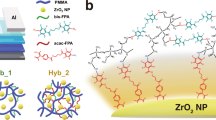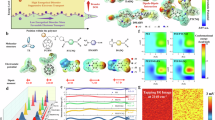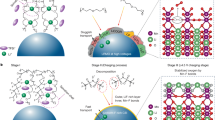Abstract
While ultrafast charging and discharging is highly desired for energy storage, the densely packed crystalline inorganic electrodes suffer from sluggish ion transport that limits this capability. Here we report two-dimensional vertical ladder polymer cathode materials that feature layered nanosheets with rich intralayer pores and structural defects alongside weak interlayer interactions. This structural design allows lithium ions to migrate vertically across the intrinsic pores and/or defects accompanied by horizontal intercalation, thus establishing a cross-flow pathway for lithium storage. Such an effective ion-transport method enables flash charging of an ultrahigh-power polymer cathode to ~70% state-of-charge within 30 s at a high current density. Even operated at −50 °C, the polymer cathode achieves 3-min charging to ~55% state-of-charge. Furthermore, we propose an organic–inorganic hybrid strategy that overall improves the electrode-level specific energy at high rates for meeting practical metrics. This work demonstrates the potential of organic electrodes for high-power output under extreme operational conditions.

This is a preview of subscription content, access via your institution
Access options
Access Nature and 54 other Nature Portfolio journals
Get Nature+, our best-value online-access subscription
$32.99 / 30 days
cancel any time
Subscribe to this journal
Receive 12 print issues and online access
$259.00 per year
only $21.58 per issue
Buy this article
- Purchase on SpringerLink
- Instant access to full article PDF
Prices may be subject to local taxes which are calculated during checkout






Similar content being viewed by others
Data availability
All data supporting the findings of this study are available within the article and Supplementary information. Source data are provided with this paper.
References
Viswanathan, V. et al. The challenges and opportunities of battery-powered flight. Nature 601, 519–525 (2022).
Yang, X.-G., Liu, T., Ge, S., Rountree, E. & Wang, C.-Y. Challenges and key requirements of batteries for electric vertical takeoff and landing aircraft. Joule 5, 1644–1659 (2021).
Wang, C.-Y. et al. Fast charging of energy-dense lithium-ion batteries. Nature 611, 485–490 (2022).
Howell, D., Simon, P. & Gogotsi, Y. Perspectives for electrochemical capacitors and related devices. Nat. Mater. 19, 1151–1163 (2020).
Liu, Y., Zhu, Y. & Cui, Y. Challenges and opportunities towards fast-charging battery materials. Nat. Energy 4, 540–550 (2019).
Yuan, M., Liu, H. & Ran, F. Fast-charging cathode materials for lithium & sodium ion batteries. Mater. Today 63, 360–379 (2023).
Weiss, M. et al. Fast charging of lithium-ion batteries: a review of materials aspects. Adv. Energy Mater. 11, 2101126 (2021).
Sun, H. et al. Three-dimensional holey-graphene niobia composite architectures for ultrahigh-rate energy storage. Science 356, 599–604 (2017).
Tu, S. et al. Fast-charging capability of graphite-based lithium-ion batteries enabled by Li3P-based crystalline solid–electrolyte interphase. Nat. Energy 8, 1365–1374 (2023).
Billaud, J., Bouville, F., Magrini, T., Villevieille, C. & Studart, A. R. Magnetically aligned graphite electrodes for high-rate performance Li-ion batteries. Nat. Energy 1, 16097 (2016).
Noh, H.-J. et al. Cathode material with nanorod structure––an application for advanced high-energy and safe lithium batteries. Chem. Mater. 25, 2109–2115 (2013).
Liang, L. et al. Nasicon-type surface functional modification in core shell LiNi0.5Mn0.3Co0.2O2@NaTi2(PO4)3 cathode enhances its high-voltage cycling stability and rate capacity toward Li-ion batteries. ACS Appl. Mater. Interfaces 10, 5498–5510 (2018).
Xu, X. et al. Radially oriented single-crystal primary nanosheets enable ultrahigh rate and cycling properties of LiNi0.8Co0.1Mn0.1O2 cathode material for lithium-ion batteries. Adv. Energy Mater. 9, 1803963 (2019).
Wen, J., Ma, X., Li, L., Zhang, X. & Wang, B. Ion transport phenomena in electrode materials. Chem. Phys. Rev. 4, 021302 (2023).
Liu, W. et al. Nickel-rich layered lithium transition-metal oxide for high-energy lithium-ion batteries. Angew. Chem. Int. Ed. 54, 4440–4457 (2015).
Wang, J. & Sun, X. Olivine LiFePO4: the remaining challenges for future energy storage. Energy Environ. Sci. 8, 1110–1138 (2015).
Cao, Y. et al. Covalent organic framework for rechargeable batteries: mechanisms and properties of ionic conduction. Adv. Energy Mater. 12, 2200057 (2022).
Henrique, F., Zuk, P. J. & Gupta, A. A network model to predict ionic transport in porous materials. Proc. Natl Acad. Sci. USA 121, e2401656121 (2024).
Sun, H. et al. Hierarchical 3D electrodes for electrochemical energy storage. Nat. Rev. Mater. 4, 45–60 (2019).
Mangrulkar, C. K., Dhoble, A. S., Chamoli, S., Gupta, A. & Gawande, V. B. Recent advancement in heat transfer and fluid flow characteristics in cross flow heat exchangers. Renew. Sust. Energ. Rev. 113, 109220 (2019).
Rayess et al. Cross-flow microfiltration applied to oenology: a review. J. Membr. Sci. 382, 1–19 (2011).
Li, W., Erickson, E. M. & Manthiram, A. High-nickel layered oxide cathodes for lithium-based automotive batteries. Nat. Energy 5, 26–34 (2020).
Sun, T., Xie, J., Guo, W., Li, D.-S. & Zhang, Q. Covalent-organic frameworks: advanced organic electrode materials for rechargeable batteries. Adv. Energy Mater. 10, 1904199 (2020).
Zhu, D. et al. Covalent organic frameworks for batteries. Adv. Funct. Mater. 31, 2100505 (2021).
Sun, J., Xu, Y., Lv, Y., Zhang, Q. & Zhou, X. Recent advances in covalent organic framework electrode materials for alkali metal-ion batteries. CCS Chem 5, 1259–1267 (2023).
Wang, S. et al. Exfoliation of covalent organic frameworks into few-layer redox-active nanosheets as cathode materials for lithium-ion batteries. J. Am. Chem. Soc. 139, 4258–4261 (2017).
Wang, Z. et al. Few layer covalent organic frameworks with graphene sheets as cathode materials for lithium-ion batteries. Nanoscale 11, 5330–5335 (2019).
Liu, X. et al. In situ growth of covalent organic framework nanosheets on graphene as the cathode for long-life high-capacity lithium-ion batteries. Adv. Mater. 34, 2203605 (2022).
Jiang, Y. & Chen, C.-F. Recent developments in synthesis and applications of triptycene and pentiptycene derivatives. Eur. J. Org. Chem. 2011, 6377–6403 (2011).
Chen, C.-F. & Han, Y. Triptycene-derived macrocyclic arenes: from calixarenes to helicarenes. Acc. Chem. Res. 51, 2093–2106 (2018).
Seiki, N. et al. Rational synthesis of organic thin films with exceptional long-range structural integrity. Science 348, 1122–1126 (2015).
Wang, A. et al. Solution-processable redox-active polymers of intrinsic microporosity for electrochemical energy storage. J. Am. Chem. Soc. 144, 17198–17208 (2022).
Kissel, P. et al. A nanoporous two-dimensional polymer by single-crystal-to-single-crystal photopolymerization. Nat. Chem. 6, 774–778 (2014).
Li, P. et al. Interpenetration isomerism in triptycene-based hydrogen-bonded organic frameworks. Angew. Chem. Int. Ed. 58, 1664–1669 (2019).
Lv, J. et al. A triptycene-based 2D MOF with vertically extended structure for improving the electrocatalytic performance of CO2 to methane. Angew. Chem. Int. Ed. 62, e202217958 (2023).
Zhou, T.-Y., Lin, F., Li, Z.-T. & Zhao, X. Single-step solution-phase synthesis of free-standing two-dimensional polymers and their evolution into hollow spheres. Macromolecules 46, 7745–7752 (2013).
Kwon, J. E. et al. Triptycene-based quinone molecules showing multi-electron redox reactions for large capacity and high energy organic cathode materials in Li-ion batteries. J. Mater. Chem. A 6, 3134–3140 (2018).
Shoji, Y., Yamamoto, S. & Fukushima, T. Perchlorinated triptycene tribenzoquinone. Chem. Lett. 50, 1240–1243 (2021).
Ong, W. J. & Swager, T. M. Dynamic self-correcting nucleophilic aromatic substitution. Nat. Chem. 10, 1023–1030 (2018).
Zeng, Y. et al. Irreversible synthesis of an ultrastrong two-dimensional polymeric material. Nature 602, 91–95 (2022).
Wang, T. et al. Ultasfast 3D hybrid-ion transport in porous V2O5 cathodes for superior-rate rechargeable aqueous zinc batteries. Adv. Energy Mater. 13, 2204358 (2023).
Zhang, H., Sun, W., Chen, X. & Wang, Y. Few-layered fluorinated triazine-based covalent organic nanosheets for high-performance alkali organic batteries. ACS Nano 13, 14252–14261 (2019).
Zheng, Y. et al. Accelerating ion dynamics under cryogenic conditions by the amorphization of crystalline cathodes. Adv. Mater. 33, 2102634 (2021).
Lu, Y., Zhang, Q., Li, L., Niu, Z. & Chen, J. Design strategies towards enhancing the performance of organic electrode materials in metal-ion batteries. Chem 4, 2786–2813 (2018).
Wild, A., Strumpf, M., Häupler, B., Hager, M. D. & Schubert, U. S. All-organic battery composed of thianthrene- and TCAQ-based polymers. Adv. Energy Mater. 7, 1601415 (2017).
Xie, J., Wang, Z., Xu, Z. J. & Zhang, Q. Toward a high-performance all-plastic full battery with a single organic polymer as both cathode and anode. Adv. Energy Mater. 8, 1703509 (2018).
Lu, Y. & Chen, J. Prospects of organic electrode materials for practical lithium batteries. Nat. Rev. Chem. 4, 127–142 (2020).
Poizot, P. et al. Opportunities and challenges for organic electrodes in electrochemical energy storage. Chem. Rev. 120, 6490–6557 (2020).
Mao, M. et al. Electronic conductive inorganic cathodes promising high-energy organic batteries. Adv. Mater. 33, 2005781 (2021).
Kim, J. et al. Organic batteries for a greener rechargeable world. Nat. Rev. Mater. 8, 54–70 (2023).
Acknowledgements
We thank the Testing Technology Center of Materials and Devices of Tsinghua Shenzhen International Graduate School (SIGS) for providing the technical assistance on characterization. This work is financially supported by Guangdong Provincial Department of Science and Technology (grant nos. 2023ZT10L039 and 2021QN02C070 to Z.C.), Shenzhen Science and Technology Program (grant nos. KQTD20240729102048053 and JCYJ20220530143006014 to Z.C.) and the scientific research startup fund (grant nos. QD2021018C to Z.C. and QD2021029C to L.P.) and the cross-disciplinary research and innovation fund (grant no. JC2022006 to Z.C.) from Tsinghua SIGS.
Author information
Authors and Affiliations
Contributions
X.D. and Z.C. conceived of the idea and designed the experiments. X.D. conducted the synthesis, characterization and measurements. L.L. conducted the partial synthesis and measurements. S.Z. and Q.C. performed the theoretical calculation. Y.C. and M.L. carried out the solid-state NMR experiments. X.Z., H.W., T.H., M.L., D.Z. and L.P. participated in the data analysis and discussion. Z.C. and L.P. led the project. X.D. and Z.C. drafted the paper.
Corresponding authors
Ethics declarations
Competing interests
Tsinghua University and Z.C., X.D. and L.L. have filed a patent (no. 2024102707896) for the synthetic method of polymer cathodes reported in this paper. The other authors declare no competing interests.
Peer review
Peer review information
Nature Chemistry thanks Ji Eon Kwon, Qilei Song and the other, anonymous, reviewer(s) for their contribution to the peer review of this work.
Additional information
Publisher’s note Springer Nature remains neutral with regard to jurisdictional claims in published maps and institutional affiliations.
Supplementary information
Supplementary Information
Supplementary Method, Notes 1–3, Figs. 1–44 and Tables 1–6.
Supplementary Data 1
Cartesian coordination of modelling compounds.
Supplementary Data 2
CONTCAR of 2DVLPs associated with Li.
Source data
Source Data Fig. 2
Raw data for Fig. 2.
Source Data Fig. 3
Raw data for Fig. 3.
Source Data Fig. 4
Raw data for Fig. 4.
Source Data Fig. 5
Raw data for Fig. 5.
Source Data Fig. 6
Raw data for Fig. 6.
Rights and permissions
Springer Nature or its licensor (e.g. a society or other partner) holds exclusive rights to this article under a publishing agreement with the author(s) or other rightsholder(s); author self-archiving of the accepted manuscript version of this article is solely governed by the terms of such publishing agreement and applicable law.
About this article
Cite this article
Deng, X., Liu, L., Zhang, S. et al. Ultrafast charging of two-dimensional polymer cathodes enabled by cross-flow structure design. Nat. Chem. 17, 1546–1555 (2025). https://doi.org/10.1038/s41557-025-01899-5
Received:
Accepted:
Published:
Issue date:
DOI: https://doi.org/10.1038/s41557-025-01899-5



